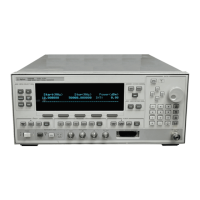Getting Started with
SCPI
This section of Chapter 1 describ es the use of the Standard
Commands for Programmable Instruments language (SCPI). This
section explains how to use SCPI commands in general. The
instrument command summary (at the end of this chapter) lists
the specic commands available in your instrument. This section
presents only the basics of SCPI. If you want to explore the topic in
greater depth, see the paragraph titled, \Related Do cuments."
Definitions of Terms
This section denes most terms when they are rst used, you need a
general understanding of the terms listed below before you continue.
controller
A controller is any computer used to communicate
with a SCPI instrument. A controller can b e a
personal computer, a minicomputer, or a plug-in card
in a card cage. Some intelligent instruments can also
function as controllers.
instrument
An instrumentis any device that implements SCPI.
Most instruments are electronic measurementor
stimulus devices, but this is not a requiremen
t.
Similarly, most instruments use an GPIB interface
for communication. The same concepts apply
regardless of the instrument function or the type of
interface used.
program
message
A program message is a combination of one
or more prop erly formatted SCPI commands.
Program messages always go from a controller to an
instrument. Program messages tell the instrument
how to make measurements and output signals.
resp onse
message
A response message is a collection of data in sp ecic
SCPI formats. Response messages always go from an
instrument to a controller or listening instrument.
Resp onse messages tell the controller ab out the
internal state of the instrument and ab out measured
values.
command
A command is an instruction in SCPI. You
combine commands to form messages that control
instruments. In general, a command consists of
mnemonics (keywords), parameters, and punctuation.
query
A query is a special type of command. Queries
instruct the instrument to make response data
available to the controller. Query mnemonics always
end with a question mark.
Getting Started Programming 1-63

